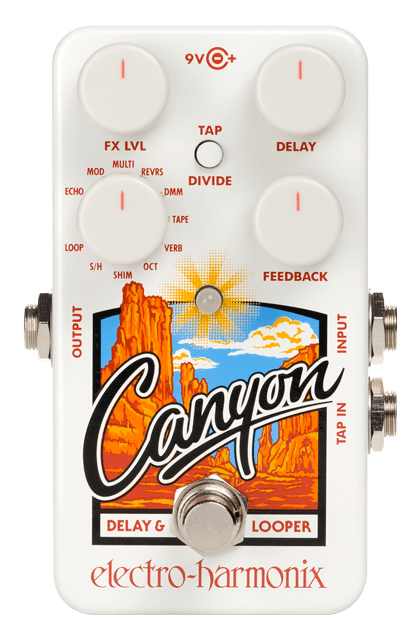
The Electro-Harmonix Canyon Delay and Looper exemplifies EHX’s reputation for quality guitar pedals. This small white box is a Swiss army knife of superb time-based effects, featuring reverbs, delay, and a looper for good measure. It’s one of the best pedals around, and now that its big brother the Grand Canyon has been released, it’s worth visiting what makes the original Canyon so amazing.
Specifications
The Electro-Harmonix Canyon takes a standard 9V Boss-style power input, and a 9V power supply is included. It features 11 modes covering a huge range of functionality, which I’ll delve into later in this article. It takes a mono input and has a mono output. The footswitch is silent. The Canyon has an external tap-tempo input, but if you don’t have an external tap tempo pedal, you can use the pedal’s main footswitch to set tempo instead.
There are four knobs, all of which are pretty intuitive:
- FX level;
- delay;
- mode; and
- feedback.
In addition to these knobs, there’s a lot of functionality hidden behind a “Tap Divide” button. Not only will this button cycle between “divide” modes (you can change the delay division from 1/8th notes to dotted 1/8th notes to 1/4 notes, indicated by the LED color), but if you hold the button you’ll unlock “Secondary Knob Mode”, in which the “Delay” and “Feedback” knobs will start to control different effect parameters.
Delay Modes
The Electro-Harmonix Canyon’s 11 modes represent almost every kind of delay mode you can imagine, with some extra non-delay modes just in case. I’ll list the modes, give a quick description, and tell you what I think about them.
Standard Modes
- Echo: A simple digital delay. This mode is a little bit bland, but sometimes a simple, clean delay effect is what you need.
- Mod: Same as Echo mode, but with subtle modulation. This has a little more charm than Echo mode and lends itself to more creative playing.
- Multi: A multi-tap delay, where the repeats play at the same volume as the original note without fading out as with other modes. I like this mode for an aggressive, stuttery sound.
- Reverse: Exactly what the name suggests. In theory, this is a cool feature, but I find it needs thoughtful tweaking in Secondary Knob Mode to really make it exciting.
- DMM: An emulation of EHX’s legendary Deluxe Memory Man pedal. This is similar to Mod mode, but with richer modulation. With some attentive tweaking in Secondary Knob Mode, you can get a very lush sound.
- Tape: Emulates the classic lo-fi tape delays of yesteryear. This is the mode I use most. I really like the grittiness and warmth available via Secondary Knob Mode, especially when I’m not playing with distortion.
Not-so-standard Modes
- Verb: Adds a plate-emulated reverb to each delay repeat, and can be tweaked to serve exclusively as a reverb. To be honest, I think this is one of the Canyon’s weakest modes. It has very little of the texture and character of a reverb-specific pedal. If this is the only “normal” reverb you own, though, it’s better than nothing.
- Oct: This mode adds octave-shifted repeats, enabling some crazy synth-style sounds. If you turn the delay time and feedback all the way down, you can get a one-up-one-down octave effect, which is pretty cool. I don’t use this mode much, but it’s good fun.
- Shim: This is a “shimmer” mode, with pitch-shifted delays creating a wash of harmony. I haven’t found a shimmer sound I like (see my review of the MXR Reverb) and this one is no exception, but if you’re desperate for shimmer then this is a decent start.
- S/H (Sample and Hold): Play a note in this mode and it will repeat indefinitely until you play another one. This is multi-tap on steroids and has all sorts of interesting creative implications.
- Looper: A basic looper similar to eg the Boss RC-1. It has a maximum loop length of 62 seconds; small compared to a dedicated looper, but a great start regardless.
Why the Canyon?
I’m not in love with all of the Electro-Harmonix Canyon’s modes, so why does it never leave my pedalboard? Simply put, the Canyon has a superior combination of versatility, quality, and practicality for money. I can’t afford a different pedal for each flavor of delay I might potentially want to use, but that doesn’t mean I want to sacrifice quality. For the key delay modes I’m interested in – clean digital, subtle modulation, tape emulation, reverse – I want to feel like I’m getting great bang for my buck, which the Electro-Harmonix Canyon gives abundantly. Furthermore, for a delay to be practical in a band setting, I need the ability to make tempo adjustments on the fly, so tap tempo is necessary.
The Canyon pairs amazingly with my Behringer VD400 Analog Delay. By combining the former’s digital clarity with the latter’s analog warmth, and staggering the pedals’ delay times, I can create a huge atmospheric tone.
Conclusion
The Electro-Harmonix Canyon is a superb pedal and is a must-have for your pedalboard. Check it out!

Comments (1)
Behringer VD400 Vintage Delay – Guitar Pedal Review – Var Guitar
April 27, 2020 at 4:30 pm
[…] maximum delay time is just 300ms, which isn’t much compared to a digital delay like an EHX Canyon or Boss RV-3. Although you can increase the delay time by tweaking internal pots, it comes at the […]
Comments are closed.